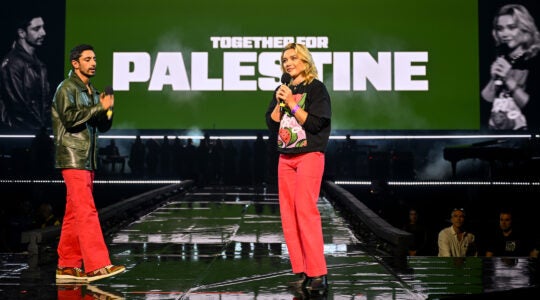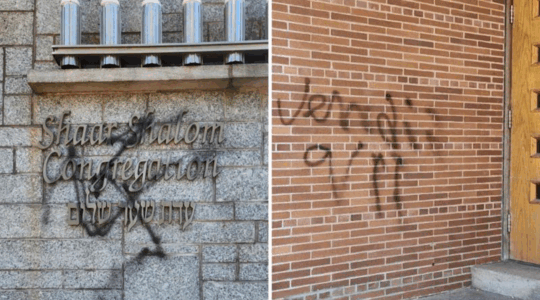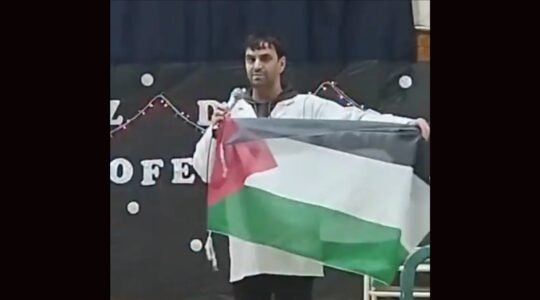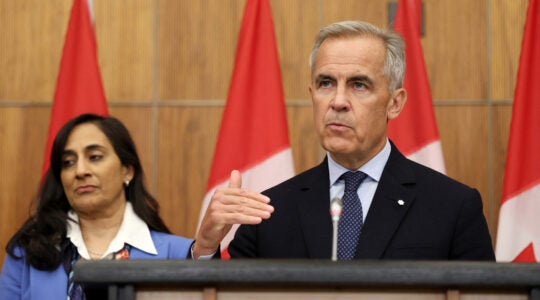
Part of the monument at the Paneriai Forest in Vilnius, where tens of thousands were massacred. The site is now a memorial park. (Ruth Ellen Gruber)

Stairs leading down to the Wall of Names section of the vast 5-year-old monument at the site of the Nazi death camp in Belzec, Poland. (Ruth Ellen Gruber)

Inscription at the entrance to the monument at the site of the Belzec death camp in southeastern Poland, where some 500,000 Jews were killed. (Ruth Ellen Gruber)

The Ghetto Heroes monument, erected in Warsaw in 1948 on the site of the World War II Warsaw Ghetto, will stand behind the new Museum of the History of Polish Jews. (Ruth Ellen Gruber)

Holocaust memorial in the shape of a weeping willow tree, erected in 1990 in back of the Dohany Street Synagogue in Budapest. (Ruth Ellen Gruber)
ROME (JTA) — Under communism, Jewish suffering in World War II generally was treated as a footnote to the overall losses in what the Soviets called the “Great Patriotic War.”
Public monuments existed at some Holocaust sites in Eastern Europe, such as Auschwitz, the Paneriai forest near Vilnius where at least 70,000 Jews were killed, and Babi Yar, where tens of thousands of Jews were killed in ravines outside Kiev. But these usually commemorated generic “victims of fascism” and did not acknowledge the involvement of local collaborators.
Since the fall of communism 20 years ago, however, a host of new Holocaust memorials have gone up in post-communist states while and Communist-era monuments have been revamped by state authorities, local civic groups and Jewish organizations, giving the Jewish tragedy of World War II more prominence.
The new memorials range from simple plaques to modest monuments to huge memorial complexes, such as the monument at the Belzec death camp. A joint project of the Polish government and the American Jewish Committee, the monument was inaugurated in 2004 by the Polish president.
Some new sites, such as Belzec and the state-run Holocaust memorial center in Budapest, which also opened in 2004, include museums or educational facilities.
In other cases, including at Babi Yar and Paneriai, new inscriptions or components have been added to provide more accurate information and context in order for the memorial site to teach and inform as well as commemorate.
This can become contentious if, for example, the new inscriptions make reference to local collaboration in the killing of Jews.
“After the problem of funding, the hardest part of getting monuments and memorials erected has not been getting some kind of general consent, but it has been working out the specifics of the design and especially the language on the inscription,” said the president of the International Survey of Jewish Monuments, Samuel Gruber, who has written about Holocaust memory and consulted on Holocaust monument projects.
“Most older memorials have been very general in their language, so much so that it is often hard to figure out what events are being commemorated, and rarely can one learn about who did what to whom and when,” he said.
This remains a concern, even with monuments whose positioning and design make them prominent. Some memorials form a striking symbolic presence, but provide little or no information as to what they commemorate. Visitors are presumed to know already what they represent.
In the heart of the Slovak capital Bratislava, for example, a chiseled image of a destroyed synagogue now serves as a Holocaust memorial. But other than the word “Remember,” no information is provided on how the wartime fascist state collaborated with the Nazis in killing most of Slovakia’s 135,000-strong prewar Jewish community.
Likewise, in Sopron, Hungary, a small but powerful sculptural monument depicting empty clothing hung outside the Auschwitz gas chambers stands near an abandoned synagogue. The memorial bears Hebrew lettering and the Sh’ma prayer, but no further information.
“How can one remember what one doesn’t know?” Gruber said. “How can one ‘not forget’ what is never fully discussed or taught?”
On Slovakia’s Holocaust Memorial Day, Sept. 9, Slovak Prime Minister Robert Fico presided over the dedication of a memorial to Slovaks who helped rescue Jews at the time of the anti-Nazi Slovak National Uprising in 1944.
Funded by the Israeli Chamber of Commerce in Slovakia and several private sources, the memorial was built in the town of Zvolen next to the mass gravesite of Jews who were killed by the Nazis. It also includes a digital information point.
“This represents a different way of presenting Slovak national history that is at the same time a rejection of the [Nazi-allied] Slovak national puppet state of Josef Tiso,” said Rabbi Andrew Baker, the American Jewish Committee’s director of international Jewish affairs who has advised on Holocaust memorial projects in several countries. “Fico deserves credit for doing this, and he also speaks emotionally about the importance of Holocaust education in his country.”
Though flawed at times, the memorials serve an important purpose.
“Memorials have a permanent presence,” said Warren Miller, chairman of the U.S. Commission for the Preservation of America’s Heritage Abroad, which has been involved in Holocaust memorial projects in Latvia, Romania, the former East Germany and other countries. “Going to a powerful memorial will help people want to learn more.”
For a JTA video on Holocaust memorials in Berlin, visit http://blogs.jta.org/wanderingjew/article/2009/10/24/1008699/hidden-memorials-in-berlin.
JTA has documented Jewish history in real-time for over a century. Keep our journalism strong by joining us in supporting independent, award-winning reporting.





